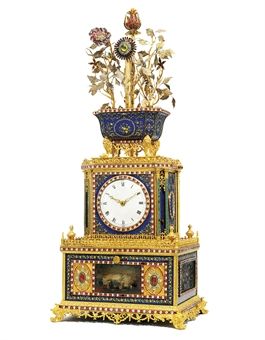AN IMPERIAL CHINESE ORMOLU, ENAMEL AND PASTE-SET STRIKING 'JARDINIERE' CLOCK - GUANGZHOU WORKSHOPS. QIANLONG PERIOD (1736-1795)
AN EXCEPTIONAL IMPERIAL CHINESE ORMOLU, ENAMEL AND PASTE-SET STRIKING, MUSICAL AND AUTOMATON 'JARDINIERE' CLOCK - GUANGZHOU WORKSHOPS. QIANLONG PERIOD (1736-1795), LATE 18TH CENTURY
CASE: modelled in three tiers;
The base section of rectangular form banded with red and white paste gems and raised on four foliate scroll cast ormolu feet with floral swags between, decorated to all sides with red and green floral enamels and gold foils on a translucent blue basse-taille enamelled ground, the front and two sides with automaton scenes (see below) and the rear with silk-backed pierced ormolu rectangular panel, also with paper inventory label 8, the front panel with recessed automaton scene (see below) flanked by paste-set stars framed within an oval cartouche;
The middle section with platform framed by an openwork ormolu gallery, each corner mounted with an ormolu vase (formerly with automaton floral bouquets), this section with cast ormolu base with raised scroll decoration and with further openwork gallery above, the canted angles each with green paste gem-set double Corinthian pilasters with plain blue enamel panels between, each of the sides decorated with red, gold and green floral enamels on a translucent blue basse-taille enamelled ground, centred by floral enamelled oval cartouches within red and white paste-set borders, the rear decorated with conforming enamels and centred by silk-backed pierced repoussé ormolu circular panel decorated with flowerheads and leafy sprigs, the front also with matching enamels and set with the clock dial;
The upper section formed as an octagonal jardiniere supported on four elaborate foliate ormolu feet and raised on a leaf-engraved platform, with panels of basse-taille enamels between red and white paste-set borders, issuing sprays of gilt and silvered foil leaves mounted with multi-coloured paste-set flowerheads, three of them 'trembling' naturalistically and two of them automata (see below)
DIAL: with red and white paste-set bezel and convex glass to white enamel dial with crossed minute track, Roman hour and Arabic quarter chapters, the pierced ormolu hands set via knob to the front of the tier below
AUTOMATA: hourly, or at will by pulling a knob to the right front angle of the case, to the front of the base tier a recessed scene framed with foliage and with backdrop painted with buildings has two lines of painted metal European figures parading with gardening tools and attributes; to the sides, painted and pierced panels show tropical birds amidst foliage, backed by spiral-twist glass rods to simulate waterfalls (automata connections lacking); the floral bouquet in the jardiniere has a revolving flowerhead to the front and is centred by a later ormolu pineapple finial intended to rise and fall as the paste-set leaves around it open and then close (automaton connections lacking); all while music plays
CLOCK AND MUSICAL AUTOMATA MOVEMENT: (probably English, adapted and finished in China) with triple chain and fusees wound from the rear and knife-edge verge escapement, the back plate engraved with leafy sprigs, with hour strike on bell and hourly music playing one tune via a pinned cylinder on eight bells with eight hammers, with drive to the automaton flowerhead above and to the parading figures at the front
30¾ in. (78 cm.) high x 13¼ in. (33.7 cm.) wide x 10¼ in. (26 cm.) deep - Price Realized: HK$39,527,500 ($5,087,308)
COMPARATIVE LITERATURE: Liao Pin ed., Clocks and Watches of the Qing Dynasty, From the Collection in the Forbidden City, Beijing, 2002
For another jardiniere clock see lot 1505 and footnote. A jardiniere clock in the Palace Museum, Beijing shows automaton flowers of closely related design to those found on the present clock but which are not fully functioning (see Liao Pin, p.55). On the Beijing clock a flower also spins to the front and when the petals open a fairy rises from the flower; a similar figure was probably originally in place on this clock.
Christie's. Magnificent Clocks for the Chinese Imperial Court from the Nezu Museum. 27 May 2008

/https%3A%2F%2Fprofilepics.canalblog.com%2Fprofilepics%2F1%2F0%2F100183.jpg)
/https%3A%2F%2Fstorage.canalblog.com%2F03%2F02%2F119589%2F96711876_o.jpg)
/https%3A%2F%2Fstorage.canalblog.com%2F11%2F31%2F119589%2F94773502_o.jpg)
/https%3A%2F%2Fstorage.canalblog.com%2F20%2F83%2F119589%2F94772815_o.jpg)
/https%3A%2F%2Fstorage.canalblog.com%2F26%2F72%2F119589%2F75604929_o.jpg)
/https%3A%2F%2Fstorage.canalblog.com%2F59%2F60%2F119589%2F26458628_o.jpg)



/image%2F1371349%2F20240515%2Fob_d1ec88_telechargement-11.jpg)
/image%2F1371349%2F20240515%2Fob_8609d5_telechargement-7.jpg)
/image%2F1371349%2F20240515%2Fob_ad0b40_telechargement-6.jpg)
/image%2F1371349%2F20240515%2Fob_a1c116_telechargement-4.jpg)